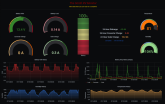bsmith993
New Member
- Joined
- Jul 22, 2020
- Messages
- 8
Hi folks. Discovered Will's YT channel and was thoroughly impressed. Great videos, Will. Couple hours later and I've been enjoying reading this forum. I currently have a "starter" system on my RV consisting of 2 Renogy 100 watt panels, a Renogy 30a Wanderer controller and just a dealer provided, el cheapo flooded battery. I'm REALLY anxious to get more battery in there.
My unique component is my homegrown battery and charge monitor. I'm a home automation enthusiast / data freak and there is nothing better to me than really being able to present a whole mountain of data on stuff that matters to everybo.... I mean, no one other than me. It is still quite a work in progress and someday I'll have a full rundown on everything for the DIY side of the forum, but for now I'll give a broad view.
Alongside my basic solar system, I have a 12v branch in my front electronics bay with 2 12v-5v buck converters. One powers a Nighthawk wifi hotspot, and the other a Raspberry Pi model 3 mini computer. Perched on top of my Raspberry is my own design and custom printed circuit board that consists of 2 analog-digital converters so that my Raspberry can read voltage to calculate amperage over 3 shunts (solar charge IN, converter charge IN, and house load OUT) , along with a simple voltage divider circuit so my raspberry can read the current battery voltage. I have a python script I wrote running on the Raspberry that sends data every 10 seconds or so reporting to my Amazon Web Services hosted VM running an Influx database to capture all data points. Then I use a Grafana front end to display data. Grafana is a nice tool because I can customize the view of data however complex or simple I like, for any time period, and it can even make a nice "app" like interface for a smartphone. Further, since I use a regular old lead acid battery, I profiled my battery voltages in my python script based upon load so I can get an "estimated" battery capacity despite the current load. (No more false low readings or waiting for rest periods to see state of charge. i.e. 12.5v at rest may only be 80%, but 12.5v while pulling 5amps would still be near 100%. At least in my testing. So I correct for that in real time. Take that, dummy button on my RV panel!!) I live in an area where my RV cannot be stored at home so the nice thing for me is that I get a constant, AND archived data feed on the health of my system all the time, even when in storage.
Detailed 7 day view: Note the daily charge patterns with a relatively idle battery. And yes, my humidity readings are currently whack.

Smartphone view:

And my groovy PCB. Ignore my sloppy header soldering job.

Someday soon I'll get pics of the electronics bay in the RV, and will have source code and more detailed info if anyone were to ever be interested.
Anyway, glad to be part of this forum and look forward to learning and possibly even contributing from you all!
My unique component is my homegrown battery and charge monitor. I'm a home automation enthusiast / data freak and there is nothing better to me than really being able to present a whole mountain of data on stuff that matters to everybo.... I mean, no one other than me. It is still quite a work in progress and someday I'll have a full rundown on everything for the DIY side of the forum, but for now I'll give a broad view.
Alongside my basic solar system, I have a 12v branch in my front electronics bay with 2 12v-5v buck converters. One powers a Nighthawk wifi hotspot, and the other a Raspberry Pi model 3 mini computer. Perched on top of my Raspberry is my own design and custom printed circuit board that consists of 2 analog-digital converters so that my Raspberry can read voltage to calculate amperage over 3 shunts (solar charge IN, converter charge IN, and house load OUT) , along with a simple voltage divider circuit so my raspberry can read the current battery voltage. I have a python script I wrote running on the Raspberry that sends data every 10 seconds or so reporting to my Amazon Web Services hosted VM running an Influx database to capture all data points. Then I use a Grafana front end to display data. Grafana is a nice tool because I can customize the view of data however complex or simple I like, for any time period, and it can even make a nice "app" like interface for a smartphone. Further, since I use a regular old lead acid battery, I profiled my battery voltages in my python script based upon load so I can get an "estimated" battery capacity despite the current load. (No more false low readings or waiting for rest periods to see state of charge. i.e. 12.5v at rest may only be 80%, but 12.5v while pulling 5amps would still be near 100%. At least in my testing. So I correct for that in real time. Take that, dummy button on my RV panel!!) I live in an area where my RV cannot be stored at home so the nice thing for me is that I get a constant, AND archived data feed on the health of my system all the time, even when in storage.
Detailed 7 day view: Note the daily charge patterns with a relatively idle battery. And yes, my humidity readings are currently whack.

Smartphone view:

And my groovy PCB. Ignore my sloppy header soldering job.

Someday soon I'll get pics of the electronics bay in the RV, and will have source code and more detailed info if anyone were to ever be interested.
Anyway, glad to be part of this forum and look forward to learning and possibly even contributing from you all!
Last edited:



